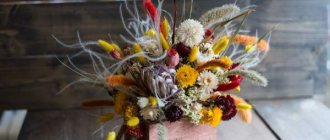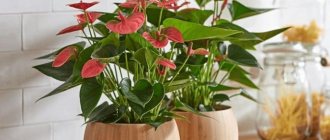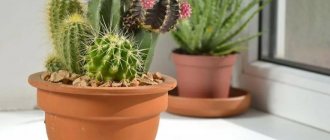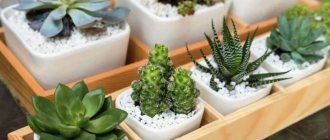A guest from South America, Monstera is a very beautiful decorative vine with large carved leaves. It can often be seen in offices; some people like to grow such a plant in residential premises. There are quite contradictory opinions about the monster. Some consider this plant not only beautiful, but also useful. Others, who believe in omens and superstitions, claim that this plant should not be kept in the house. Some believe that when a monstera is in the house, omens come true, while others grow it and do not observe any negative effects.
Dispelling popular myths
Monstera, an inhabitant of humid subtropics, reaches gigantic sizes in natural conditions. This large vine grows up to 40 meters or more in length, twining around tall trees. Additional long roots grow on its trunks, which can hang all the way to the ground, entwining and growing through everything that gets in their way.
In past centuries, travelers in South America often found monstera thickets in the jungle, next to which lay the skeletons of people and animals, riddled with the roots of these plants. The sight was terrible. In fact, these were the remains of those who accidentally died not far from these thickets, and the roots then grew through everything that came across their path.
But among many peoples there were legends about a dangerous plant that lured travelers and then pierced them with its roots. Since then, monstera (translated as “monster”, “monster”) has retained an ominous mystical reputation. This is the reason why you can’t keep a monstera at home. In fact, this is a very beautiful and rather harmless plant, if you follow some precautions for its maintenance.
Types of Philodendron
The homeland of the plant, which comes from the aroid family, is considered to be the equatorial part of Central and South America. Species diversity is represented by 30 species; only a few of them are adapted for indoor maintenance:
- Monstera tenuis – thin;
- Monstera obliqua – oblique, also unequal-sided;
- Monstera deliciosa – delicacy, also lovely;
- Adanson's Monstera (Monstera adansonii) - pierced or (Monstera pertusa) perforated.
Monstera species and varieties video review:
Currently, selection has given flower growers plants with variegated leaves, but for now, monstera with dark green foliage is more often found in the interior.
Why is the plant dangerous?
Many people grow this beautiful exotic plant in their apartments without any harm to themselves or others. But it has some features that must be taken into account when placing:
- During the day, the monstera releases oxygen, and at night it actively absorbs it. Therefore, it cannot be kept in the bedroom, especially in a small one. In general, this plant is quite large (it grows up to 3-5 meters indoors) and is suitable only for spacious rooms, especially with such properties. It belongs in offices, greenhouses, and large living rooms, where it looks very impressive.
- Whether Monstera is poisonous or not depends on the part of the plant. The juice of its leaves is poisonous (can cause poisoning and irritation of mucous membranes), so it is not recommended to grow it where there are small children or animals. Moreover, with poisonous leaves (if you chew them, you can get poisoned), it has very tasty edible fruits.
- Some esotericists consider the monstera to be an energy vampire, so they do not recommend placing it in the bedroom so as not to feel weak and overwhelmed.
Benefit or harm
A new plant that appears in the house is a reason to think about its beneficial and harmful properties. The harmful qualities of monstera include all of the above myths, which remain unconfirmed.
The only thing that can harm a plant is its leaves, which upon direct contact cause irritation of the mucous membrane.
Adults are unlikely to think of tasting the plant, but kids can.
Many people believe that this plant is completely poisonous, but people in India deny this. They consume plant flowers in unlimited quantities.
Monstera fruits are very tasty
Monstera is known not only for its negative aspects, but also for its benefits to humans:
- Monster improves the microclimate of the room in which it is located, that is, a comfortable level of humidity is created.
- The plant absorbs harmful formaldehyde released by some building materials. A unique ability unique to this plant.
- Externally, the liana is a very beautiful plant that can enliven any room .
- It is called the "green barometer" because the vine can predict the weather . For example, if droplets of water appear on the leaves, it means that it will rain very soon.
- Residents of Asia believe that the plant brings joy, good luck and health .
Knowledgeable people advise those who have a bad and negative home atmosphere to get a Monstera.
Useful properties of the flower
This flower has much more beneficial properties:
- In practice, it has been proven that this plant absorbs negative energy and can relieve headaches. To do this, you just need to stay a little near her.
- In many southern countries, this plant is considered a strong talisman for the hearth and is often planted near the house. And if you place it next to a sick person, he will quickly recover.
- It is believed that it helps improve thought processes and concentration. Therefore, in institutions it can often be seen in conference rooms and other rooms. Many believe that it creates excellent conditions for business negotiations and has a positive effect on making the right choice.
- According to Feng Shui, Monstera is perceived as a symbol and helps to make important decisions.
- It has been noticed that Monstera is an excellent green filter in the room, effectively purifying the air from dust and harmful impurities. Also, it perfectly suppresses the development of viruses and pathogenic microorganisms. It is good to place it in dry rooms to normalize air humidity.
- Monstera actively absorbs harmful micro- and electric waves and other radiation. Therefore, by placing it next to the refrigerator, microwave, TV or other household appliances, you will significantly reduce their harmful effects on the body.
Where to put it in the apartment?
According to Feng Shui, monstera has a beneficial effect on the energy of space and helps to find peace. You can place a pot with a plant in the kitchen, hallway, living room or hallway. These rooms are best suited if you want to put your thoughts in order and achieve a state of harmony.
If you have an office at home, it will also be a suitable place for a monstera. While there, the flower will help you develop business skills and climb the career ladder. also recommended to keep the monstera in offices and near any workplace. This is an excellent plant for those who want to build a successful career and achieve financial well-being.
Perhaps the only place where you can’t put a monstera is the bedroom. It is believed that it cools marital relationships.
This is just a belief, but it’s not worth the risk when there are plenty of other suitable places to place the flower.
Is it worth starting a house?
So, it has much more beneficial properties than harmful ones. Therefore, everyone decides for themselves whether it is possible to keep a monstera flower at home. This plant not only serves as an excellent interior decoration, but can also fill the home with a favorable atmosphere. It is best to keep it in a spacious hallway or living room; some people find a place for it in the kitchen. But it is not recommended to place it in the bedroom or children's room.
If you are distrustful of monstera , then it is better not to have it in your home, because this flower is very sensitive to negativity and will not grow well in such conditions. With careful handling, the monstera can even bloom, although this rarely happens at home. When deciding to have one at home, you should first study its features and how to properly care for it.
Pests, diseases, possible problems - table
Diseases and pests rarely affect the vine, but sometimes they cause its death. The plant's leaves may curl, fall off, turn yellow, and dry out.
| Plant diseases | External signs | Fighting methods |
| Chlorosis (carried by aphids and mites) | Yellowing of leaves, appearance of light spots. | Processing with phytofarm. Feeding. Maintaining cleanliness. |
| Root rot | Yellowing and wilting of leaves. | Regulating the watering regime. Removing rotten roots and sprinkling the cuts with charcoal. |
| Spider mite | The appearance of yellow spots and spots on the leaf blades. Falling leaves. Presence of white cobwebs. | Treatment with phytoferm or derris. Regular shower with warm water. |
| Aphid | Curling, deformation and drying of young leaves. | Treatment with insecticide against aphids and preparations with permethrin. |
| Shchitovka | The appearance of hard brown plaques on the back of the leaves, drying of the tips. | Repeated treatment with a damp cloth with soapy water and insecticide. |
Description of monstera
The monstera liana has another name “philodendron”, which means “amazing”, “bizarre”. Despite its gigantic size in natural conditions, the vine indoors usually grows up to 3 meters, less often up to 5 meters.
It has large, beautiful, carved leaves with numerous holes in the middle. They appeared so that in natural conditions, where there are often heavy tropical downpours, the leaves are not damaged by powerful flows of water. Young shoots have small , heart-shaped leaves without holes.
In the jungle, vines curl around tree trunks. At home, you need to install a support about 1 meter high in a pot, wrapped in sphagnum moss, which must be constantly moistened.
On its stems, upper roots grow in different places, which cannot be removed so that the plant can develop normally. They are quite delicate and must be handled with care and sprayed periodically. When they grow, it is better to dig them in with soil in a pot. But if they are already too large, then separate containers are added for them - pots with soil or jars with water.
Planting, replanting, pruning, support
When planting a plant, you need to pay attention to the soil. It should be loose and neutral. There are several mixture options:
- take one part each of humus, peat and sand and add 2 parts of turf;
- mix one part each of bark, leaf soil, peat, moss and ½ part coarse sand;
- Add coconut fiber or perlite to the purchased soil for Saintpaulia.
Young vines should be replanted annually, as they grow very quickly. The pot should be 2-3 cm larger than the old one. It is better if its height and diameter are approximately equal. In a cramped container, the leaves may turn brown and thin, like papyrus.
The soil, drainage material and container must first be sterilized. Drainage should occupy approximately a fifth of the volume.
The plant must be replanted carefully, along with a lump of earth. Dry damaged roots must be trimmed. The vine is placed in the middle of the new container, covered with earth and lightly compacted.
Adult vines are replanted after two years. You will need fairly large flowerpots. It will depend on them how large the vine will be. The new container should be larger than the old one so that the root system feels comfortable.
Since the plant is quite large, it is better to transplant it together. Make the transplant step by step.
Replanting a very large monstera is a difficult task, so over time, only the top old layer of soil is changed with the addition of humus. If you don’t want such problems, you can start a mini plant.
A young monstera definitely needs support, as it curls. In addition, the vine will look more attractive. It is placed in a permanent place and sprayed. For an adult plant, you can make the support yourself. Sticks with coconut fiber are not a very suitable option, as it is difficult for the vine to gain a foothold. To make a support, you can take a piece of plastic tube, longer than the plant, and drill many slots in it. Next, place it in a pot and pour sand inside to the surface of the soil. Moss mixed with peat should be poured on top. The support is wrapped with damp moss, a mesh with cells on top and secured with fishing line. This design also requires regular spraying. Other options are possible.
The plant grows aerial roots, but they cannot be removed. If a vine climbs up a moss tube, the roots will grow into it themselves.
When an adult plant stops growing intensively, you can cut off its top for rejuvenation. The cut should be sprinkled with coal. This procedure promotes the growth of side shoots and crown formation.
Tips for proper care
A guest from the tropics loves a humid , warm microclimate, good lighting without direct rays. Capricious - does not like touches and drafts. When the air humidity is high or rainy weather is approaching, droplets of water appear on the leaves - a living barometer in the house.
- Watering. Despite the fact that it loves moisture, too much watering is harmful and can lead to rotting of the roots and falling leaves. It is better to periodically spray the leaves and upper roots with moderate watering. By the way, the leaves should be wiped with a soft sponge to remove dust, but only mature ones - young ones should not be used, as they can be damaged.
- Soil and replanting. Neutral and universal soils are suitable for monstera. Young plants are transplanted into larger pots every spring, and when they grow too large, some of the soil in the pot is only renewed without replanting.
- Reproduction. Young plants are easily grown in many ways: from seeds, stem cuttings, leaves, apical cuttings, aerial roots.
- Pests and diseases. Susceptible to spider mites and scale insects. With improper care (overdrying or waterlogging), the leaves may turn yellow and black.
Monstera at home
Signs and superstitions
Monstera is often called a “crybaby” or a barometer. Before rain, air humidity rises and droplets of juice appear on the leaves of the vine - in the tropics this serves as a reliable sign of imminent precipitation.
Sometimes it is called a “vampire”, citing its ability to take energy: first the plant collects all the negativity, and then gets to the positive vibrations. However, it does not “drink”, but balances: it removes excess, normalizes, and brings it to an optimal state.
According to popular superstition, the monstera drives suitors away from girls and, as a result, its owner risks being left alone. There is no justification for this sign, but based on logic, it can be assumed that men with negative energy and dishonest intentions dare. A brave, sincere and loving person is unlikely to change plans because of a plant.
Its gloomy image was created by legends of travelers who found human skeletons in its roots. From the outside it seemed as if the monster had strangled the unfortunate man. However, the solution turned out to be simple: people in the jungle died from various causes (disease, thirst, wild animals, poisoned arrows, etc.), and the vine simply wrapped itself around them with stems and aerial roots.











